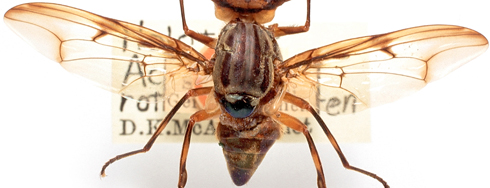Biology
Size
Body length 13.5-16mm, wing length 14-16.5mm
The males have long eye-stalks, which vary in size so that the distance between the eyes ranges from about 20 to 55mm. The holotype of this species has the widest head of any known fly.
The females only have very short eye-stalks, the head width only reaching up to 7.6mm.
The length of the eye-stalks varies among the males, and it is most likely that the different lengths of the stalks indicate a hierarchy, males with longer stalks being dominant over those with shorter stalks, and achieving greater reproductive success.
Growth
At the moment the immature stages of Achias are unknown. The biology of Platystomatidae in general is poorly known, but the larvae in structure are fairly typical fly maggots, with no legs and their bodies tapering anteriorly.
The larvae are also headless, having instead a cephalopharyngeal skeleton with sclerotised mouth-hooks which tear off pieces of food and guide it into the mouth of the larva. The larvae go through three instars, most of the growth taking place during the final (third) instar. When fully grown the larval skin hardens to form a protective capsule (puparium) inside which a fragile pupa is formed. Pupariation usually takes place on the ground among soil or leaf-litter.
